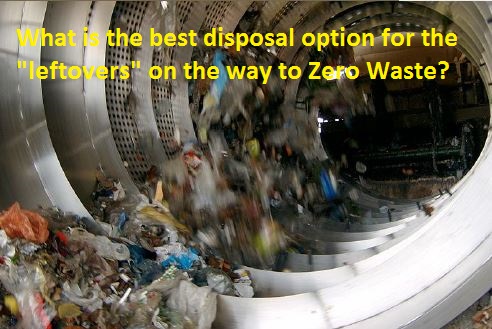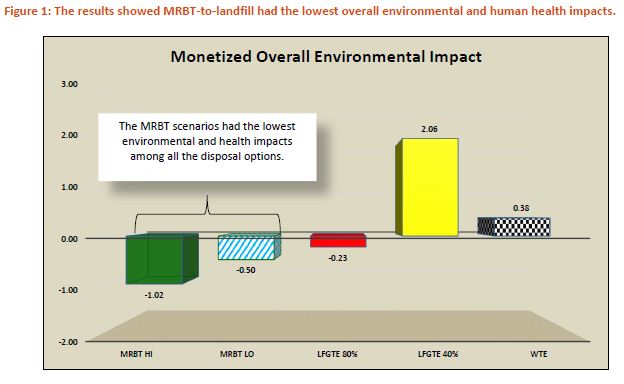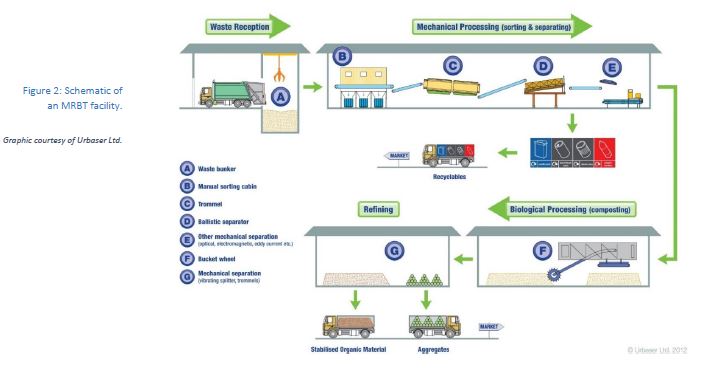What to do with the “leftovers” of Zero Waste

Zero Waste is about minimising waste generation, maximising reuse & recycle and redesigning the economy in order to phase out those products that are either toxic or not recyclable.
During the time in which we can’t stop producers from selling badly designed stuff we need to find the best option to treat the waste that today can’t be recycled or composted and which amounts to 5 to 20% of total household waste -depending on the community-. For instance in the first European town to declare Zero Waste, Capannori, this amounts to 8%. In the Gipuzkoa province the waste that is not recyclable is 19%.
So what to do with what is left? According to a scientific study recently published the disposal option with the lowest impact is MRBT to landfill, or in other words, pre-treat the waste, recover as much as possible, biologically stabilise and landfill it.
The European Commission and the waste incineration industry promote the belief that after maximizing recycling, reuse and composting, the best thing a community can do with leftover waste is to create energy with it. But this is a political choice with little science behind.
A new lifecycle analysis report, which compares the environmental impacts of the three most common disposal methods used globally, finds that the best approach to protecting the public health and the environment isn’t mass burn waste-to-energy, and it isn’t landfill gas-to-energy. The report found that, after aggressive community-wide recycling, reuse and composting, the most environmentally-sound disposal option for any waste that may still remain is a third option: Materials Recovery, Biological Treatment (MRBT).
 Material Recovery, Biological Treatment is a process to “pre-treat” mixed waste before landfilling in order to recover even more dry materials for recycling and minimize greenhouse gas and other emissions caused by landfilling by stabilizing the organic fraction with a composting-like process. Very similar to the MBT systems used widely in Europe, the goal of MRBT is to capture any remaining recyclables and then create inert residuals that will produce little to no landfill gas when buried. The system can also classify non-recyclable dry items for the purpose of identifying industrial design change opportunities, which helps to drive further waste reduction.
Material Recovery, Biological Treatment is a process to “pre-treat” mixed waste before landfilling in order to recover even more dry materials for recycling and minimize greenhouse gas and other emissions caused by landfilling by stabilizing the organic fraction with a composting-like process. Very similar to the MBT systems used widely in Europe, the goal of MRBT is to capture any remaining recyclables and then create inert residuals that will produce little to no landfill gas when buried. The system can also classify non-recyclable dry items for the purpose of identifying industrial design change opportunities, which helps to drive further waste reduction.
This report emphasizes that source separation for recycling and composting is still the best environmental option for managing all discards and should be the focus of community efforts. However, “on the way to Zero Waste” there is still the need to reduce the negative impacts of disposal and minimize the need to invest in new disposal facilities. Communities should look beyond the two traditional options—burying and burning—toward building MRBT systems that have the lowest overall environmental impact of the technologies commercially available today.
Using a tool developed by economist Dr. Jeffrey Morris called MEBCalcTM, or Measuring Environmental Benefits Calculator, the study compared the three disposal strategies—MRBT, mass burn waste-to-energy and landfill gas-to-energy—across seven environmental categories, including climate change, water pollution, air pollution and human health impacts.
The MRBT system was shown to be the best choice for a community to dispose of its leftovers because it recovers the greatest amount of additional recyclables, stabilizes the organic fraction of the residuals, reduces the amount of material to be disposed of in a landfill, and minimizes the negative environmental and public health impacts of landfilling leftovers compared to the other disposal alternatives, landfill gas-to-energy or mass-burn waste-to-energy.
 “MRBT is not a replacement or substitution for source separation, but it is a tool for helping communities reduce the environmental impacts of managing their leftovers as they progress on their way to Zero Waste,” says Eric Lombardi, the Executive Director of Eco-Cycle and sponsor of the study.
“MRBT is not a replacement or substitution for source separation, but it is a tool for helping communities reduce the environmental impacts of managing their leftovers as they progress on their way to Zero Waste,” says Eric Lombardi, the Executive Director of Eco-Cycle and sponsor of the study.
When utilized in a community with successful recycling and composting programs, MRBT has further benefits beyond its lower environmental impacts. Because the pre-treatment process includes additional sorting and recovery of recyclable dry materials, MRBT can help support very high levels of landfill diversion. The study modeled an 87% diversion rate for the city of Seattle, Washington based on 71% diversion from current source-separated recycling efforts and an additional 16% from the MRBT process, including increased recovery of recyclables and the weight reduction of the organic materials from moisture evaporation and biogenic carbon conversion to carbon dioxide.
MRBT infrastructure is also flexible and dual-purposed, able to handle both mixed waste and source-separated recyclables and organics. This means a community is not tied to feeding the facility a continuous flow of mixed waste over the next several decades and is not investing in a future of ever-more waste. Rather, as a community’s Zero Waste efforts improve, the MRBT model can adjust to a declining volume of leftover waste and support the growth of source separated collection systems. In addition, MRBT infrastructure can be built and operational on a shorter time scale than landfills and incinerators, and can be modular in size to help communities manage their leftover waste more locally.
According to Joan Marc Simon, Founder of Zero Waste Europe, “This report is exactly what we need at the right time to help guide the debate on what to do with residuals once we reach high separate collection rates. Europe has over-invested in waste incineration and needs solutions that deliver environmental safety while still focusing on increasing recycling and reducing material consumption.”
The report was an international effort authored by Dr. Jeffrey Morris, an economist and life-cycle assessment expert with Sound Resource Management Group based in Olympia, Washington; Dr. Enzo Favoino, Senior Researcher at Scuola Agraria del Parco di Monza in Milan, Italy; Eric Lombardi, Executive Director of Eco-Cycle, a Zero Waste social enterprise based in Boulder, Colorado; and Kate Bailey, Senior Analyst for Eco-Cycle.
The full report, “What is the best disposal option for the ‘Leftovers’ on the way to Zero Waste?” is available at www.ecocycle.org/specialreports/leftovers.